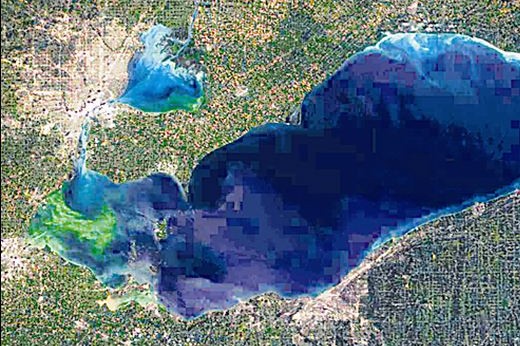Podcast: Play in new window | Download
Subscribe: RSS

Algae blooms on Lake Erie, virtually covering its Eastern bay in this August photo from space, are killing the lake. Again. And we know who the killer is.
Declared dead in the 1970s, brought back to life by the environmental movement it did much to inspire, Lake Erie is once again expiring, killed by industrial agriculture. Specifically, phosphorous from synthetic fertilizers, which the aforementioned environmental movement never gained the clout to regulate. After having been reduced by two-thirds with various buffering and conservation practices, phosphorous levels in Lake Erie are, according to an Ohio State University expert, “back up to when it was considered a dead lake.”
The expert, Jeff Reutter, director of the Ohio Sea Grant and Stone Laboratory, was speaking this week at the State of the Lakes Ecosystem Conference in Erie, Pennsylvania. He did not have to explain to the conference why the phosphorous causes problems — it stimulates the growth of algae, some of which produce deadly toxins, all of which create dense mats that kill virtually everything else in the water.
Nor did he have to explain where it comes from; fertilizer, mainly, plus some commercial detergents and some waste-water treatments. What he and others are trying to explain is why the phosphorous/algae situation has got so much worse so fast? [I reported on the problem a few months ago in Losing the War on Pond Scum]
The emerging answer is that global climate change, that ubiquitous threat multiplier, is at work here as well. It gets warmer earlier in the year on Lake Erie now, and stay warmer longer, giving the algae more time to multiply. “We are seeing blooms as early as April and as late as October,” says Reutter. But much bigger contributors, he says, are the bigger, more frequent storms and heavier rainfalls of recent years, which have been washing ever more phosphorous into the lake.
(Here’s a mystery never explained to me: virtually every ounce of phosphorous that washes into our waters was bought to stimulate crops, and therefore its loss represents a very real economic loss to the practitioners of industrial agriculture. Why have they not fixed this? Is it so much easier to get more subsidies than to take measures to stop throwing money away?)
The upshot is that the size of this year’s algae blooms on Lake Erie, and the size of the dead zones created by the blooms, set all-time records, while phosphorous levels equalled the records set in the 1970s. The culprit clearly is industrial agriculture, whose depredations are magnified by climate change, but the country’s policy makers find big agriculture untouchable and climate change deniable.
The raucous Ignorati [thanks for the word, Joe Romm] have so intimidated the lamestream media [thanks, Sarah Palin] that even Reuters, still a serious news organization, feels it necessary to inject this sentence into its account of the problem: “Some climate scientists say warming temperatures may be making extreme weather events more common.” “Some?” “May?” The sentence implies that there are other serious climate scientists who deny it. Find one.
Similarly the Detroit Free Press, in an otherwise hard-hitting piece, adds “Farmers made dramatic improvements in reducing the sediments that got swept away-only to find now that the phosphorus somehow escapes on its own to nourish the algae.” Really? Fugitive phosphorous molecules running through the night with sirens sounding and searchlights flashing? It escapes on its own?
At least one government official (I want to change his name to protect the innocent) said it like it was at the conference. Cameron Davis, senior advisor with the Environmental Protection Agency, said this: “After decades of studying and reporting … we largely know what the solutions are. We need to double down on the efforts to reduce phosphorous.”
Good luck with your career, Cameron. And RIP, Lake Erie.
-0-
http://witsendnj.blogspot.com/2011/10/ponder-pond.html
Ponds everywhere are full of algae, like this one photographed near my house in New Jersey. I was just in Santa Cruz, CA and saw the same thing in a pond next to the beach there. Neither one is near agricultural runoff. Could that be from the Acidification of the World?
about algal blooms, wiki says:
Freshwater algal blooms are the result of an excess of nutrients, particularly phosphorus.[1] The excess of nutrients may originate from fertilizers that are applied to land for agricultural or recreational purposes, these nutrients can then enter watersheds through water runoff.[2] Excess carbon and nitrogen have also been suspected as causes.
Don’t read their entry on fertilizer. It will ruin your day.
We are developing a branding and awareness campaign to help Save Lake Erie. Please visit SaveLakeErie.com and share the videos with others. This is such an important issue and with the economy and everything else going on, it’s very difficult to get people excited. We’re changing that.
Thanks for your help!
Todd
SaveLakeErie.com
I wish you all the best of success. Please provide updates.